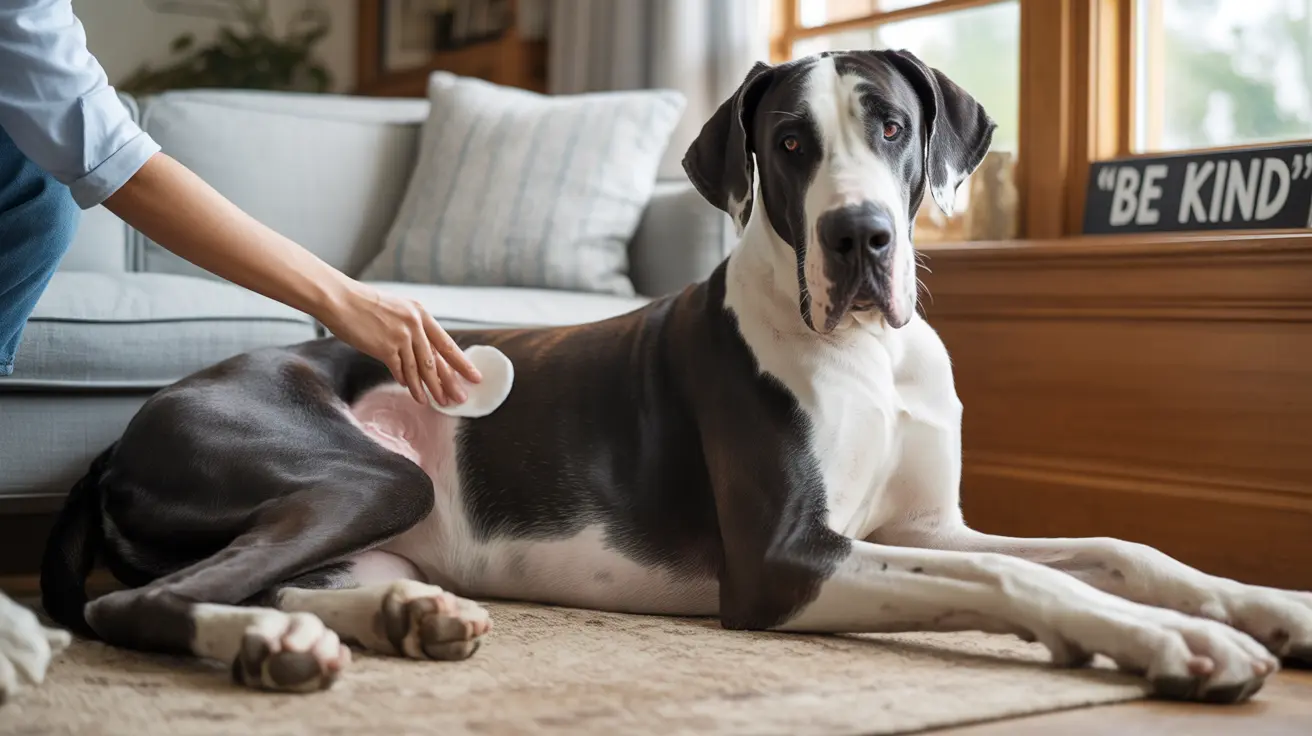Hot spots, medically known as acute moist dermatitis, represent one of the most common and distressing skin conditions affecting our canine companions. These rapidly developing lesions can quickly transform from minor irritations into painful, inflamed wounds that significantly impact a dog's quality of life. Understanding how to identify, treat, and prevent hot spots is crucial for every dog owner.
As a rapidly escalating condition, hot spots require prompt attention and proper care to ensure effective healing. When left untreated, these lesions can expand dramatically within hours or days, leading to severe discomfort and potential complications. This comprehensive guide will walk you through everything you need to know about managing and preventing hot spots in dogs.
Identifying Hot Spots: What to Look For
A hot spot typically appears as a red, moist, and inflamed patch of skin that feels warm to the touch. These lesions most commonly develop on the face, neck, limbs, and hips, though they can occur anywhere on your dog's body. The affected area often shows noticeable hair loss and may emit an unpleasant odor due to bacterial infection. Early recognition of these symptoms is essential to limit the severity and spread of the lesion.
Key Symptoms to Watch For
- Red, swollen, and moist skin patches often accompanied by a shiny or wet appearance due to constant licking
- Visible hair loss around the affected area, leaving exposed skin vulnerable to further infection
- Persistent scratching or licking of the spot, which exacerbates inflammation and disrupts healing
- Oozing or bleeding from the lesion, sometimes with a crust forming over the wound
- Noticeable discomfort when touched, with some dogs becoming protective or irritable if the area is handled
- Foul odor emanating from the wound, indicating bacterial growth or infection
If you observe any of these symptoms, it's important to act quickly to begin treatment and prevent the condition from worsening.
Understanding the Causes
Multiple factors can trigger hot spots in dogs, making prevention and treatment a multi-faceted approach. Determining the underlying reason for the development of a hot spot can help you address the root cause and minimize recurrence. Triggers may be environmental, behavioral, or related to the dog's overall health.
Primary Triggers
- Allergic reactions to food or environmental factors, such as pollen, dust mites, or chemicals, can create itchy skin that dogs instinctively lick or scratch.
- Flea, tick, or other parasitic infestations lead to intense itching and self-trauma, which often breaks the skin and introduces bacteria.
- Moisture trapped in thick or matted fur provides a perfect breeding ground for bacteria, especially in humid climates or after swimming.
- Poor grooming practices can result in tangles or mats, trapping dirt and moisture against the skin.
- Stress or anxiety-induced behaviors sometimes cause obsessive licking, chewing, or scratching, opening the door to skin infections.
- Underlying medical conditions such as skin infections, hormonal imbalances, or immune system issues may predispose a dog to hot spots.
- Physical irritants or foreign bodies such as burrs or insect stings can break the skin and cause irritation that escalates to a hot spot.
Professional Treatment Options
While mild hot spots might respond well to home management, professional veterinary intervention is often necessary, especially for severe, quickly spreading, or recurrent lesions. A veterinarian can provide a thorough diagnosis, effective medications, and guidance on underlying causes. Neglecting to seek veterinary attention for more serious cases can result in prolonged discomfort or complications, such as deeper skin infections.
Standard Treatment Protocol
- Careful clipping and cleaning of the affected area to remove hair and debris, allowing better access for topical treatment and monitoring.
- Application of appropriate antibiotics and anti-inflammatory medications, often in the form of topical ointments or, for more severe infections, oral medications to control bacteria and reduce inflammation.
- Use of protective collars (such as an Elizabethan or "cone" collar) to prevent further licking or scratching, which can hinder the healing process.
- Treatment of underlying causes, such as addressing flea infestations, managing allergies, or reducing sources of stress, to prevent recurrence.
- Regular monitoring of healing progress, with follow-up appointments as needed to ensure effective recovery and make necessary adjustments to the treatment plan.
Your veterinarian will tailor treatment to your dog's specific situation, so follow all advice carefully and complete any prescribed courses of medication.
Home Care and Management
For mild hot spots or as supportive care alongside veterinary treatment, responsible home management can promote healing, reduce discomfort, and help prevent complications. Maintaining a clean and safe environment is fundamental for your dog's skin recovery.
Essential Home Care Steps
- Gentle cleaning with veterinary-approved antiseptic solutions to remove dirt and bacteria, performed at least twice daily unless otherwise directed.
- Keeping the affected area dry and clean at all times—moisture can worsen infection or delay healing, so avoid letting your dog swim or get wet during recovery.
- Using prescribed medications exactly as directed by your veterinarian, including any topical ointments, oral medications, or sprays intended to accelerate healing and reduce infection.
- Preventing further scratching or licking by using collars, distraction techniques, or supervision, as self-inflicted trauma is a major cause of prolonged recovery.
- Monitoring the lesion's size and appearance daily to observe healing, watching for signs of improvement or any signs that indicate worsening, such as spreading redness, pus, or increased odor.
If you ever notice your dog is in significant pain, or if the hot spot seems to be expanding or not responding to home care, consult your veterinarian immediately.
Prevention Strategies
Prevention is the best approach to hot spots, and there are several proactive steps dog owners can take to minimize the risk of these painful skin lesions recurring. Consistent care and observation of your dog's habits and environment are key to maintaining healthy skin and coat.
Preventive Measures
- Regular grooming and coat maintenance helps remove dirt, loose hair, and mats that might trap moisture or irritants, especially for long-haired breeds.
- Proper drying after swimming or bathing prevents dampness that encourages bacterial growth, so always towel-dry your dog thoroughly and pay attention to trouble spots like armpits, groin, and under collars.
- Effective flea and tick prevention through monthly treatments ensures your dog is less likely to suffer bites that trigger intense scratching and self-trauma.
- Management of underlying allergies by working with your vet to identify and address food or environmental sensitivities, reducing your dog's urge to scratch or chew at their skin.
- Regular veterinary check-ups allow early detection of potential issues that could lead to hot spots, including skin disorders or hormonal imbalances.
- Stress reduction techniques such as providing sufficient mental stimulation, exercise, and a stable environment, which help prevent anxiety-related chewing or licking.
- Maintaining proper nutrition with a balanced diet supports skin health and immune function, giving your dog resilience against infections and irritations.
A proactive approach to these factors will lessen the likelihood of recurring hot spots and contribute to your pet's overall health and happiness.
Frequently Asked Questions
- What is a hot spot in dogs?
- A hot spot is a localized area of skin inflammation and microbial infection common in dogs. It appears suddenly and can grow rapidly, causing significant pain and discomfort.
- What causes hot spots in dogs?
- Hot spots are caused by irritation, allergies, insect bites, or excessive licking and scratching, often in response to discomfort or underlying health issues.
- What are the symptoms of hot spots in dogs?
- Symptoms include red, moist, painful patches of skin, often oozing or with hair loss and a strong, unpleasant odor.
- How do you treat a hot spot on a dog?
- Treatment involves cleaning the area, clipping the surrounding hair, using antibiotics or anti-inflammatory medications, and preventing further scratching, usually with a protective collar.
- Can hot spots heal on their own?
- Without proper treatment, hot spots usually worsen and can spread quickly. Veterinary care is strongly recommended for optimal healing.
- How long does it take for a hot spot to heal?
- With prompt and appropriate care, small hot spots may heal in about a week, but more severe cases can take longer.
- Are hot spots contagious to other pets or humans?
- Hot spots themselves are not contagious, but secondary infections can spread if left untreated, so good hygiene is important.
- What home remedies can help treat hot spots?
- Gently cleaning with saline or veterinary antiseptics can help, along with keeping the area dry and preventing licking. Always consult your vet before applying any remedy.
- What should you avoid doing with a dog hot spot?
- Avoid applying human medications, harsh chemicals, or irritants, and do not allow persistent scratching or delay in seeking veterinary advice.
- How can you prevent hot spots in dogs?
- Prevent hot spots by managing allergies, regular grooming, and consistent flea and tick control.
- When should you see a vet for a hot spot?
- Seek veterinary help if a hot spot is large, worsening, or not improving with home care, or if your dog is in obvious pain.
Early recognition and prompt treatment of hot spots are crucial for your dog's comfort and quick recovery. While home care can be effective for minor cases, never hesitate to seek veterinary care if the condition appears severe or worsens despite treatment. With proper attention and preventive measures, you can help your furry friend avoid the discomfort of hot spots and maintain healthy, comfortable skin.






